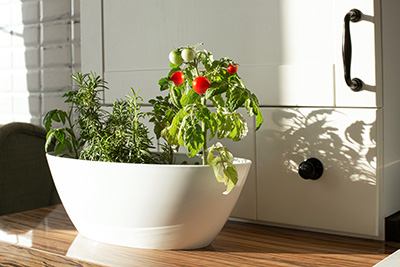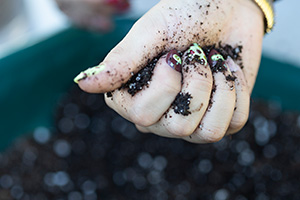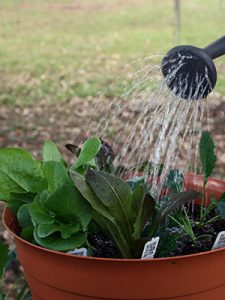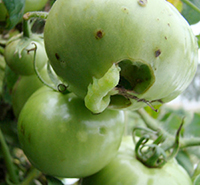Growing Vegetables in Containers
Vegetables can be grown in surprising places.

Container gardens can be on window sills, on patios, along fences, next to walkways and driveways, on porches and balconies, and even on roofs.
Growing vegetables in containers is easy, and it’s a great solution when you don’t have room for large planting beds in your landscape or just don’t want the work of creating them. There’s less maintenance than for a vegetable garden in the landscape, as fewer weeds will find their ways into the containers. Because you’re in complete control of the media used in your container garden, you won’t have the problems with nematodes that many Florida gardeners do.
Containers can be moved around the yard for aesthetic reasons, to get them out of the way, or to follow changing sunlight patterns. You can grow vegetables for longer, since containers are easier to protect or move during cold weather than beds. And containers with plants in them add beauty to the porch, patio, deck, or any other location (with adequate sun) that strikes your fancy.
Media

You’ll need to pick a media (also called a soil mix). You can choose from commercial products or make your own.
There are endless combinations you can create or buy for your potting media. Just make sure that it can hold moisture and nutrients and is porous enough to give roots access to valuable oxygen.
Some of your options for ingredients for a media mix include peat, perlite, vermiculite, granite sand, bark, coconut husks, and composted animal manure. If you don’t like your first choice, you can always try something different next season! All of the media mentioned here should be readily available from your local garden center or nursery.
Hydroponics
You can also grow many vegetables, especially greens, hydroponically. For more information about this process, which involves using a nutrient-rich solution instead of a traditional soil-based media, see our article on hydroponic vegetable gardening.
Compost
Compost is a great way to create organic nutrients for your garden and reduce the amount of waste you send to the landfill. You just mix “green” matter like kitchen scraps with “brown” stuff like dead leaves. With proper care, in six to twelve months you’ll have a nutrient-rich mixture that can be used to supplement your garden soil—whether it’s in containers or not. It’s easy to create a compost bin or heap, and there’s plenty of information around to help you. Read “Composting for the Home Gardener” for more information.
Placement (Mixing Plants in Containers)
The best way to know what to plant together is to experiment, trying different combinations of plants. Consider grouping plants with similar water needs together, such as potatoes with squashes or spinach with beans.
Think about the height of the mature plants, too: you don’t want your tall plants to shade out your smaller plants. Certain plants tend to be tall, like corn, trellised tomatoes, trellised squash, trellised beans, and okra. Other plants are of medium height, e.g., broccoli, cauliflower, collards, Swiss chard, basil, peppers, rosemary, eggplant, garlic, and celery. Then there are some shorter plants, such as radishes, onions, lettuce, thyme, oregano, carrots, strawberries, and untrellised vining crops.
There are also bush or dwarf forms of many vegetables that will defy these generalizations, and you can seek out the varieties that suit your landscape. Keep in mind that any vining plant can be trellised to support it or just to save room in your garden.
Watering
Watering is a tricky tightrope for the gardener to walk. On the one hand, overwatering your vegetables will drown them. On the other, forget to water and they’ll shrivel up and die. To complicate things even further, all plants have different water needs.

How to Water
Container gardens can often be easily hand-watered with a watering can or hose. Many plants also thrive with drip irrigation. Give your plants water until the excess runs out the bottom of the containers. Don’t ever let them sit in water—if you have dishes under the containers, empty them after watering.
When to Water
Until you get to know your garden, test the soil in your containers once a day or so by feeling for moisture with your fingertip slightly below the soil surface. When the soil feels dry, water your plants thoroughly.
Plants in clay pots and other porous containers should be watered more frequently than those in plastic pots, because they lose more water to additional evaporation out of the sides of the pots. And small pots tend to dry out more quickly than large ones.
Hot, dry weather will call for more frequent watering, and so will other environmental conditions. In other words, there’s no hard and fast rule about when to water. Plants in containers can dry out very quickly, so keep an eye on yours!
Fertilizer

Plants in containers need nutrients just like plants in the ground. There are two different kinds of fertilizer that work in different ways.
Synthetic
Add slow-release pellets to the soil during the growing season if needed. Use water-soluble fertilizer if your plants need a quick nutrient fix. Always follow fertilizer label instructions, and remember that overfertilizing can harm a plant as much as underfertilizing.
Natural
You can also use natural fertilizers like fish emulsion, composted animal manures, and homemade compost.
Pest Control
Just as many plants thrive in Florida’s climate, so do many pests. Disease, insects, and wildlife can all attack your container-grown vegetables. Luckily, vegetables grown in containers are relatively weed- and nematode-free.
IPM
Integrated pest management (IPM) is the best way to control any pests in your garden. IPM uses many different methods designed to cause the least harm to people, property, and the environment. Its emphasis is on the management, not eradication, of pests; pesticides are used only as a last resort. Prevention is the key to IPM: select the right plant for the right place, choose pest-resistant varieties, and maintain healthy plants. Visit the IPM Florida Web site for much more information.
Disease
Common vegetable diseases include damp-off, leaf spots, root and stem rots, and wilts. To prevent disease, buy disease-resistant strains of seed. If you buy transplants, check them for signs of disease before purchase. Examine your plants closely once or twice a week for early disease symptoms. Remove any diseased leaves you find. Never use chemicals until you’re sure of what’s infecting your plants. If you must spray, make sure to use the lease toxic products available—remember, you’re going to eat these plants—and always follow label directions.
Insects

Hungry insects will probably find your vegetable plants, but don’t immediately turn to pesticides—there are often better solutions. To manage insects (in your container garden, visit your veggies at least every other day, checking them closely for insects and signs of insect damage. Look under the leaves and on stems—the critters will often hide. Pick off any insects you find, crushing them or throwing them into a container of soapy water or alcohol. Cut off severely infected leaves. If you have trouble identifying any insect, save a sample and get it identified at your county Extension office. If you must use pesticides, use the least toxic product available and follow label instructions.
Wildlife
Wildlife like deer, raccoons, and squirrels can all get into your vegetables, causing damage—and headaches! For information about managing specific pest mammals, visit our Nuisance Mammals topic page.
Source:
Sydney Park Brown, Danielle Treadwell, J. M. Stephens, and Susan Webb, Florida Vegetable Gardening Guide (SP 103), Horticultural Sciences Department (rev. September 2021).
